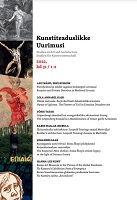Gripenbergi skandaal kui avangardistliku aktsionismi ilming
The Gripenberg Scandal as a Manifestation of Avant-garde Actionism
Author(s): Tõnis TatarSubject(s): Pre-WW I & WW I (1900 -1919), Interwar Period (1920 - 1939), History of Art
Published by: Eesti Kunstiteadlaste Ühing
Keywords: Gripenberg Scandal; Avant-garde; Actionism; art;
Summary/Abstract: The Gripenberg scandal, which was later described as ‘the biggest scandal in Estonian arts’, took place in late 1919, when Estonia had entered the final stages of its War of Independence. Maggie Gripenberg, a pioneer of modern dance from Finland, was performing in Tallinn and Tartu to celebrate the Estonians and Finns being brothers-in-arms in the ongoing war. Somewhat inexplicably, her performances in the Vanemuine Theatre in Tartu provoked a violent outburst by local bohemian avantgarde writers and artists. Gripenberg’s first show in Tartu was interrupted by whistles and foot stomping by a group of well-known Estonian writers and artists. An all-out brawl, with violent physical encounters between members of the public, young progressive-minded writers and artists and visiting performers erupted during a succeeding show. This paper analyses the causes of these incidents. It proposes the hypothesis that the aggressive intervention by leading members of the Estonian avant-garde was a peculiar local manifestation of ideas and practices of Actionism, which was prevalent in European and Russian avant-garde circles at the time.
Journal: Kunstiteaduslikke Uurimusi
- Issue Year: 31/2022
- Issue No: 01+02
- Page Range: 77-101
- Page Count: 25
- Language: Estonian
- Content File-PDF

